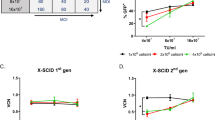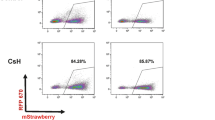Abstract
Allogeneic stem cell transplantation is often complicated by reactivation of herpesviruses. Mesenchymal stem cells (MSC) are immunomodulatory and may be used to treat graft-versus-host disease. We investigated if herpesviruses infect and can be transmitted by MSC, and if MSC suppress immune responses to various infectious agents. Mesenchymal stem cells from healthy seropositive donors were evaluated with polymerase chain reaction for the most common herpesviruses: cytomegalovirus (CMV), herpes simplex virus type 1 (HSV-1), herpes simplex virus type 2, Epstein–Barr virus (EBV) and varicella zoster virus. The cytopathological effect (CPE) was investigated and viral antigens analyzed by immunofluorescence after in vitro exposure to CMV, HSV-1 and EBV. We also studied MSC effect on lymphocyte stimulation induced by various infectious agents. No viral DNA could be detected in MSC isolated from healthy seropositive individuals. However, a CPE was noted and intracellular viral antigens detected after infection in vitro by CMV and HSV-1, but not by EBV. The CMV and HSV-1 infections were productive. Lymphocyte proliferation by herpesviruses, candida mannan and protein A from Staphylococcus aureus was suppressed by MSC. The data indicate that the risk of herpesvirus transmission by transplantation of MSC from healthy seropositive donors is low. However, MSC may be susceptible to infection if infused in a patient with CMV or HSV-1 viremia. MSC transplantation may compromise the host's defense against infectious agents.
This is a preview of subscription content, access via your institution
Access options
Subscribe to this journal
Receive 12 print issues and online access
$259.00 per year
only $21.58 per issue
Buy this article
- Purchase on Springer Link
- Instant access to full article PDF
Prices may be subject to local taxes which are calculated during checkout




Similar content being viewed by others
References
Storb R, Thomas ED . Allogeneic bone-marrow transplantation. Immunol Rev 1983; 71: 77–102.
Thomas ED, Buckner CD, Banaji M, Clift RA, Fefer A, Flournoy N et al. One hundred patients with acute leukemia treated by chemotherapy, total body irradiation, and allogeneic marrow transplantation. Blood 1977; 49: 511–533.
Ringden O . Allogeneic bone marrow transplantation for hematological malignancies – controversies and recent advances. Acta Oncol 1997; 36: 549–564.
Storb R, Thomas ED . Graft-versus-host disease in dog and man: the Seattle experience. Immunol Rev 1985; 88: 215–238.
Ringden O . Clinical spectrum of graft-versus-host-disease. In: Ferrara JLM, Burakoff S (eds). Graft vs Host Disease. Marcel Dekker Inc.: New York, 1996, pp 525–559.
Meyers JD, Thomas ED . Infection complicating bone marrow transplantation. In: Young LS (ed). Clinical approach to infection in the immunocompromised host. Plenum Press: New York, 1982, pp 507–551.
Friedenstein AJ, Petrakova KV, Kurolesova AI, Frolova GP . Heterotopic of bone marrow. Analysis of precursor cells for osteogenic and hematopoietic tissues. Transplantation 1968; 6: 230–247.
Prockop DJ . Marrow stromal cells as stem cells for nonhematopoietic tissues. Science 1997; 276: 71–74.
Bruder SP, Jaiswal N, Haynesworth SE . Growth kinetics, self-renewal, and the osteogenic potential of purified human mesenchymal stem cells during extensive subcultivation and following cryopreservation. J Cell Biochem 1997; 64: 278–294.
Pittenger MF, Mackay AM, Beck SC, Jaiswal RK, Douglas R, Mosca JD et al. Multilineage potential of adult human mesenchymal stem cells. Science 1999; 284: 143–147.
Haynesworth SE, Goshima J, Goldberg VM, Caplan AI . Characterization of cells with osteogenic potential from human marrow. Bone 1992; 13: 81–88.
Le Blanc K, Tammik L, Sundberg B, Haynesworth SE, Ringden O . Mesenchymal stem cells inhibit and stimulate mixed lymphocyte cultures and mitogenic responses independently of the major histocompatibility complex. Scand J Immunol 2003; 57: 11–20.
Tse WT, Pendleton JD, Beyer WM, Egalka MC, Guinan EC . Suppression of allogeneic T-cell proliferation by human marrow stromal cells: implications in transplantation. Transplantation 2003; 75: 389–397.
Di Nicola M, Carlo-Stella C, Magni M, Milanesi M, Longoni PD, Matteucci P et al. Human bone marrow stromal cells suppress T-lymphocyte proliferation induced by cellular or nonspecific mitogenic stimuli. Blood 2002; 99: 3838–3843.
Krampera M, Glennie S, Dyson J, Scott D, Laylor R, Simpson E et al. Bone marrow mesenchymal stem cells inhibit the response of naive and memory antigen-specific T cells to their cognate peptide. Blood 2003; 101: 3722–3729.
Bartholomew A, Sturgeon C, Siatskas M, Ferrer K, McIntosh K, Patil S et al. Mesenchymal stem cells suppress lymphocyte proliferation in vitro and prolong skin graft survival in vivo. Exp Hematol 2002; 30: 42–48.
McIntosh K . Stomal cell modulation of the immune system. Graft 2000; 3: 324–328.
Lazarus HM, Haynesworth SE, Gerson SL, Rosenthal NS, Caplan AI . Ex vivo expansion and subsequent infusion of human bone marrow-derived stromal progenitor cells (mesenchymal progenitor cells): implications for therapeutic use. Bone Marrow Transplant 1995; 16: 557–564.
Frassoni FLM, Bacigalupo A, Gluckman E, Rocha V, Bruno B, Lazarus H et al. Expanded mesenchymal stem cells (MSC), co-infused with HLA identical hematopoietic stem cell transplants, reduce acute and chronic graft-verus-host disease: a matched pair analysis. Bone Marrow Transplant 2002; 29 (Suppl 2): S2 (abstract).
Le Blanc K, Rasmusson I, Sundberg B, Gotherstrom C, Hassan M, Uzunel M et al. Treatment of severe acute graft-versus-host disease with third party haploidentical mesenchymal stem cells. Lancet 2004; 363: 1439–1441.
Koc ON, Peters C, Aubourg P, Raghavan S, Dyhouse S, DeGasperi R et al. Bone marrow-derived mesenchymal stem cells remain host-derived despite successful hematopoietic engraftment after allogeneic transplantation in patients with lysosomal and peroxisomal storage diseases. Exp Hematol 1999; 27: 1675–1681.
Le Blanc K, Ringden O . Immunobiology of human mesenchymal stem cells and future use in hematopoietic stem cell transplantation. Biol Blood Marrow Transplant 2005; 11: 321–334.
Lennon DP, Haynesworth SE, Bruder SP, Jaiswal N, Caplan AI . Human and animal mesenchymal progenitor cells from bone marrow: identification of serum for optimal selection and proliferation. In vitro Cell Dev Biol 1996; 32: 602–611.
Soderberg C, Giugni TD, Zaia JA, Larsson S, Wahlberg JM, Moller E . CD13 (human aminopeptidase N) mediates human cytomegalovirus infection. J Virol 1993; 67: 6576–6585.
Knipe DM, Howley PM . Epstein-Barr virus and its replication. In: Kieff E, Rickinson AB (eds). Fields Virology, 4 th edn. Lippincott, Williams & Wilkins: Philadelphia, 2001, pp 2511–2627.
Le Blanc K, Tammik C, Rosendahl K, Zetterberg E, Ringden O . HLA expression and immunologic properties of differentiated and undifferentiated mesenchymal stem cells. Exp Hematol 2003; 31: 890–896.
Pereira L, Hoffman M, Gallo D, Cremer N . Monoclonal antibodies to human cytomegalovirus: three surface membrane proteins with unique immunological and electrophoretic properties specify cross-reactive determinants. Infect Immun 1982; 36: 924–932.
Tollemar J, Ringden O, Holmberg K . Candida albicans: mannan and protein activation of cells from various human lymphoid organs. Scand J Immunol 1989; 30: 473–480.
Ringden O, Paulin T, Sundqvist VA, Wahren B, Pihlstedt P . Induction of immunoglobulin secretion and DNA synthesis in human lymphocytes in vitro by cytomegalovirus preparations. Scand J Immunol 1986; 24: 273–281.
Ringden O, Rynnel D . Activation of human B and T lymphocytes by protein A of Staphylococcus aureus. Eur J Immunol 1978; 8: 47–52.
Koc ON, Gerson SL, Cooper BW, Dyhouse SM, Haynesworth SE, Caplan AI et al. Rapid hematopoietic recovery after coinfusion of autologous-blood stem cells and culture-expanded marrow mesenchymal stem cells in advanced breast cancer patients receiving high-dose chemotherapy. J Clin Oncol 2000; 18: 307–316.
Maitra B, Szekely E, Gjini K, Laughlin MJ, Dennis J, Haynesworth SE et al. Human mesenchymal stem cells support unrelated donor hematopoietic stem cells and suppress T-cell activation. Bone Marrow Transplant 2004; 33: 597–604.
Almeida-Porada G, Flake AW, Glimp HA, Zanjani ED . Cotransplantation of stroma results in enhancement of engraftment and early expression of donor hematopoietic stem cells in utero. Exp Hematol 1999; 27: 1569–1575.
Almeida-Porada G, Porada CD, Tran N, Zanjani ED . Cotransplantation of human stromal cell progenitors into preimmune fetal sheep results in early appearance of human donor cells in circulation and boosts cell levels in bone marrow at later time points after transplantation. Blood 2000; 95: 3620–3627.
Angelopoulou M, Novelli E, Grove JE, Rinder HM, Civin C, Cheng L et al. Cotransplantation of human mesenchymal stem cells enhances human myelopoiesis and megakaryocytopoiesis in NOD/SCID mice. Exp Hematol 2003; 31: 413–420.
in ‘t Anker PS, Noort WA, Kruisselbrink AB, Scherjon SA, Beekhuizen W, Willemze R et al. Nonexpanded primary lung and bone marrow-derived mesenchymal cells promote the engraftment of umbilical cord blood-derived CD34(+) cells in NOD/SCID mice. Exp Hematol 2003; 31: 881–889.
Plachter B, Sinzger C, Jahn G . Cell types involved in replication and distribution of human cytomegalovirus. Adv Virus Res 1996; 46: 195–261.
Yun Z, Lewensohn-Fuchs I, Ljungman P, Ringholm L, Jonsson J, Albert J . A real-time TaqMan PCR for routine quantitation of cytomegalovirus DNA in crude leukocyte lysates from stem cell transplant patients. J Virol Methods 2003; 110: 73–79.
Crapnell KB, Almeida-Porada G, Khaiboullina S, St Jeor SC, Zanjani ED . Human haematopoietic stem cells that mediate long-term in vivo engraftment are not susceptible to infection by human cytomegalovirus. Br J Haematol 2004; 124: 676–684.
Minton EJ, Tysoe C, Sinclair JH, Sissons JG . Human cytomegalovirus infection of the monocyte/macrophage lineage in bone marrow. J Virol 1994; 68: 4017–4021.
Gao J, Dennis JE, Muzic RF, Lundberg M, Caplan AI . The dynamic in vivo distribution of bone marrow-derived mesenchymal stem cells after infusion. Cells Tissues Organs 2001; 169: 12–20.
Parsons CH, Szomju B, Kedes DH . Susceptibility of human fetal mesenchymal stem cells to Kaposi sarcoma-associated herpesvirus. Blood 2004; 104: 2736–2738.
Wang L, Mondal D, La Russa VF, Agrawal KC . Suppression of clonogenic potential of human bone marrow mesenchymal stem cells by HIV type 1: putative role of HIV type 1 tat protein and inflammatory cytokines. AIDS Res Hum Retroviruses 2002; 18: 917–931.
Acknowledgements
This study was supported by grants from the Swedish Cancer Society (4562-B03-XAC), the Children's Cancer Foundation (03/007), the Swedish Research Council (K2003-32XD-14716-01A), the Stockholm Cancer Society, the Swedish Society of Medicine and the Karolinska Institutet.
Author information
Authors and Affiliations
Corresponding author
Rights and permissions
About this article
Cite this article
Sundin, M., Örvell, C., Rasmusson, I. et al. Mesenchymal stem cells are susceptible to human herpesviruses, but viral DNA cannot be detected in the healthy seropositive individual. Bone Marrow Transplant 37, 1051–1059 (2006). https://doi.org/10.1038/sj.bmt.1705368
Received:
Revised:
Accepted:
Published:
Issue Date:
DOI: https://doi.org/10.1038/sj.bmt.1705368
Keywords
This article is cited by
-
Multipotent Stromal Cells and Viral Interaction: Current Implications for Therapy
Stem Cell Reviews and Reports (2022)
-
Mesenchymal stem cells detect and defend against gammaherpesvirus infection via the cGAS-STING pathway
Scientific Reports (2015)
-
Mesenchymal stromal cells inhibit proliferation of virus-specific CD8+ T cells
Leukemia (2014)
-
Immunosuppressive Properties of Mesenchymal Stem Cells
Stem Cell Reviews and Reports (2012)
-
Risk factors in the development of stem cell therapy
Journal of Translational Medicine (2011)



